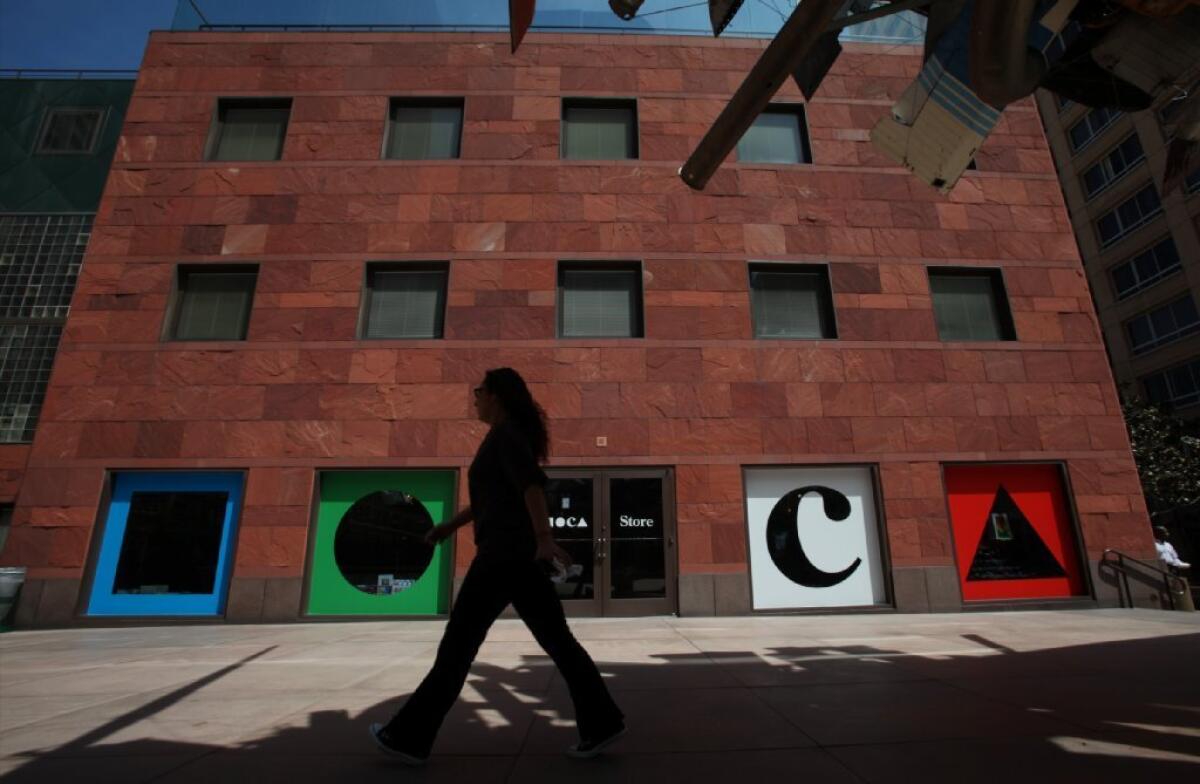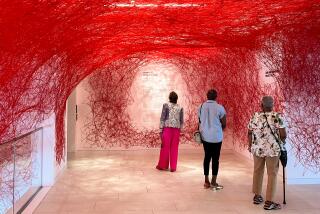Free admission to MOCA starts Jan. 11. Why the change isn’t as easy as it may seem

- Share via
Put away your wallets. Free admission to the Museum of Contemporary Art officially kicks in Jan. 11.
MOCA revealed plans to go free at its annual benefit in May, a switch made possible with a $10-million gift from board President Carolyn Powers. So why did the change take eight months to make? Free, it turns out, is complicated.
Switching to free admission typically means a significant jump in attendance, at least initially. When the Hammer Museum went free in 2014, attendance jumped 25%. Attendance at MOCA — where general admission has been $15 — was 284,160 in 2018, so a similar rise in visitor numbers would translate to about 70,000 additional people coming through MOCA’s galleries next year.
All of which means a slew of infrastructure and visitor engagement changes, such as more security guards and gallery attendants, more stanchions to contain lines, not to mention more simple amenities such as trash cans and toilet paper in the restrooms.
Then there’s the whole membership conundrum. A primary benefit to museum membership is free admission. So even as attendance rises, membership typically drops when a museum goes free. The Hammer’s membership declined by 9% the first year it went free, with an 11% drop in membership revenue, though there was a “significant increase” in people purchasing the more expensive membership packages by the next fiscal year.
MOCA is revamping its membership program, which accounts for about $500,000 annually in revenue. Asa Hursh, MOCA’s membership and annual fund manager, likens the future membership program to public radio’s “mission-driven, community-building” model.
“It’s as much about philanthropy as it is about a financial transaction for member benefits,” he says.
MOCA’s goal with free admission, director Klaus Biesenbach has said, is to remove financial barriers to entry and make the museum more accessible, encouraging repeat visits and deepening community engagement. He imagines an open door policy, much like a library. The Powers gift and decision to go free sparked conversation among curators, security, IT, visitor engagement staff, store employees and the education department as well as with board members about what being free really means and how the museum could become more accessible in other areas.
The photographer, in his first major museum show, uses a complex tonal printing process to lend richness to bland images
“It completely changed how the museum sees itself,” Biesenbach says. “We see ourselves as a civic institution, as a public institution, as a resident among residents, as part of the communities we live in. It’s about art and sharing it.”
Admission fees aren’t a big revenue-maker for museums — typically only about 7% of the annual operating budget, according to the New York-based Assn. of Art Museum Directors. MOCA has the benefit of Powers’ gift, which won’t be invested in the museum’s $136-million endowment but will be used to offset the costs of going free — about $1.8 million in its first year.
So what happens after five years, when Powers’ gift is depleted?
“You either find a new donor, that is an option, or you develop a different way of financing the museum,” Biesenbach says, adding that “we have five years to work on it.”
To help make up for the loss, MOCA will continue to charge for some special exhibitions, with the cost jumping to $18 from $15 for adult non-members.
The first full accounting by a major museum — MOCA — of the 1970s P&D movement delivers a sharp, well-placed jab to the art world’s solar plexus.
“It allows for exhibitions that we otherwise couldn’t organize, couldn’t afford and couldn’t share,” Biesenbach says of the fee, which will be waived Thursday evenings. Its first special exhibition next year will be a survey of Swiss contemporary multimedia artist Pipilotti Rist at the Geffen Contemporary satellite space in May.
MOCA also had to redesign its ticketing system, and museum trustee and Napster co-founder Sean Parker is taking the lead. For insurance purposes, guests must check in so they’re accounted for before entering the museum — something that had happened when they bought a ticket. Rather than have visitors wait in line at the ticket booth, MOCA will have self-check-in on iPads outside the ticket booth, which is also a way for the museum to capture visitors’ email addresses. The museum aims to launch online ticketing by May, so visitors can reserve free tickets in advance, as they do at the Broad museum.
A growing number of museums have adopted free admission, including the Baltimore Museum of Art in 2006 and the Dallas Museum of Art in 2013. As of 2017, 32% of the museums in the Assn. of Art Museum Directors’ membership didn’t charge admission.
But the trend is fluid, says the American Alliance of Museums’ Elizabeth Merritt.
“Some museums switch from a free to a paid model to create a new revenue stream and bolster financial stability while others eliminate admissions fees hoping to increase attendance and increase the demographic diversity of their visitors,” Merritt says. “It is worth noting that some research suggests that free admission does not in itself result in greater socioeconomic diversity among visitors. It may simply result in members of the current audience visiting more often.”
Nor is a lasting surge in attendance a sure thing with free admission. When the Baltimore Museum of Art went free, a two-year rise in attendance was followed by a drop that lasted about seven years (and partially coincided with museum renovations).
The Indianapolis Museum of Art eliminated admission in 2007 but reinstated it in 2015 because, director Charles L. Venable says, it found that the visitors who were coming for free could afford to buy a ticket anyway. Its membership, which held steady the first year, still dropped by about half over the subsequent three years. When the museum reinstated admission, attendance and membership “rose dramatically,” he says, and the museum found other ways to reach low-income visitors.
“We’ve found over and over again that price is not the biggest barrier to museum attendance,” Venable says. “Irrelevant programming is.”
Starting in January, MOCA’s accessibility efforts will include the addition of Spanish exhibition wall text and other in-gallery materials relating to its permanent collection, with additional languages to come.
And with a recent $5-million gift from MOCA trustee Wonmi Kwon and her husband, Kihong Kwon, the museum will transform its Geffen Contemporary and hold a free, performance-driven event series called Wonmi’s Warehouse Programs.
The Little Tokyo space embodies MOCA’s current thinking about connecting with the community, says Amanda Hunt, the museum’s director of education and senior curator of programs.
“The space is ground level; the doors are open; there’s a café and a bookstore,” she says. “It’s the most literal, symbolic space of being open — free and accessible to all.”
More to Read
The biggest entertainment stories
Get our big stories about Hollywood, film, television, music, arts, culture and more right in your inbox as soon as they publish.
You may occasionally receive promotional content from the Los Angeles Times.











